hktoyshop
New member
Buat bro n sis yang ingin mendapatkan moment romantis berdua dengan pasangannya...
Jangan Lewatkan Salah Satu Hujan Meteor Terbesar Tahun Ini!
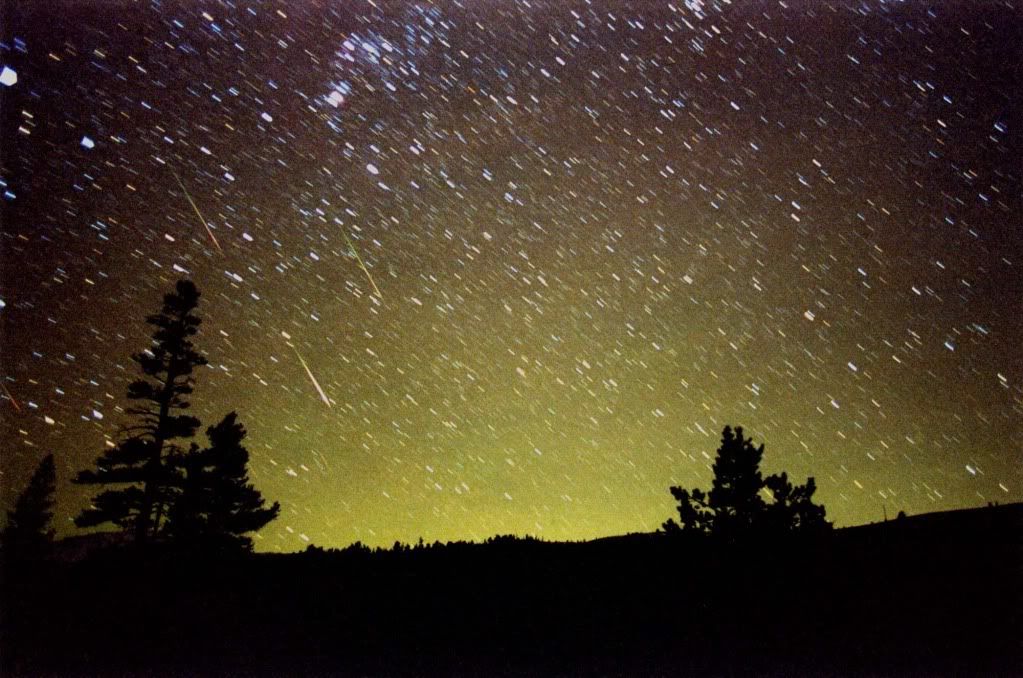
Nih berita dari website NASA
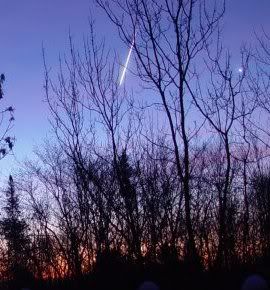
The 2009 Leonid Meteor Shower
November 10, 2009: This year's Leonid meteor shower peaks on Tuesday, Nov. 17th. If forecasters are correct, the shower should produce a mild but pretty sprinkling of meteors over North America followed by a more intense outburst over Asia. The phase of the Moon will be new, setting the stage for what could be one of the best Leonid showers in years.
see caption"We're predicting 20 to 30 meteors per hour over the Americas, and as many as 200 to 300 per hour over Asia," says Bill Cooke of NASA's Meteoroid Environment Office. "Our forecast is in good accord with independent theoretical work by other astronomers".
Leonids are bits of debris from Comet Tempel-Tuttle. Every 33 years the comet visits the inner solar system and leaves a stream of dusty debris in its wake. Many of these streams have drifted across the November portion of Earth's orbit. Whenever we hit one, meteors come flying out of the constellation Leo.
"We can predict when Earth will cross a debris stream with pretty good accuracy," says Cooke. "The intensity of the display is less certain, though, because we don't know how much debris is in each stream." Caveat observer!
The first stream crossing on Nov. 17th comes around 0900 UT (4 a.m. EST, 1 a.m. PST). The debris is a diffuse mix of particles from several old streams that should produce a gentle display of two to three dozen meteors per hour over North America. Dark skies are recommended for full effect.
"A remarkable feature of this year's shower is that Leonids will appear to be shooting almost directly out of the planet Mars," notes Cooke.
It's just a coincidence. This year, Mars happens to be passing by the Leonid radiant at the time of the shower. The Red Planet is almost twice as bright as a first magnitude star, so it makes an eye-catching companion for the Leonids: sky map.
The next stream crossing straddles the hour 2100-2200 UT, shortly before dawn in Indonesia and China. At that time, Earth will pass through a pair of streams laid down by Comet Tempel-Tuttle in 1466 and 1533 AD. The double crossing could yield as many as 300 Leonids per hour.
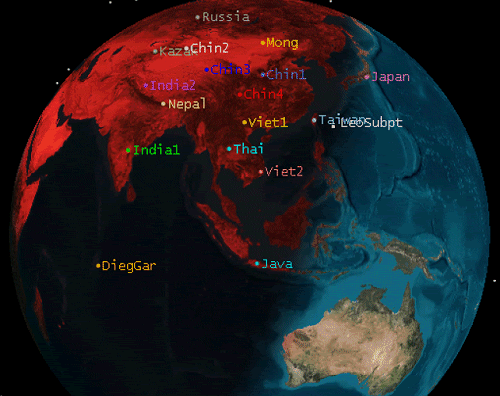
Above: This side of Earth will be facing the Leonid debris stream at the time of the Nov. 17th outburst. Observers in India, China and Indonesia are favored with dark, pre-dawn skies. Image credit: Danielle Moser of the NASA Meteoroid Environment Office.
"Even if rates are only half that number, it would still be one of the best showers of the year," says Cooke.
The Leonids are famous for storming, most recently in 1999-2002 when deep crossings of Tempel-Tuttle's debris streams produced outbursts of more than 1000 meteors per hour. The Leonids of 2009 won't be like that, but it only takes one bright Leonid streaking past Mars to make the night worthwhile.
Enjoy the show.
Author: Dr. Tony Phillips | Credit: Science@NASA
Source: http://science.nasa.gov/headlines/y2009/10nov_leonids2009.htm
Sorry gak ada translatenya, tadi ane translate di google malah jadi acak-acakan...
Nih sumber lainnya:
Lokasinya !
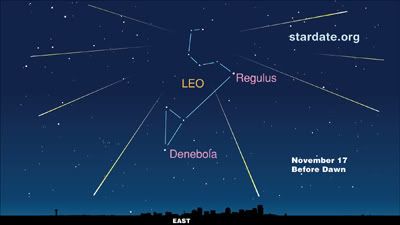
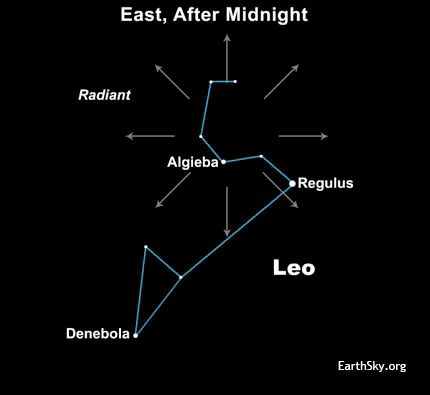
Liat jadwal Hujan Meteor 2009
Menurut sumber tertulis, aktifitas hujan meteor ini akan berlangsung pada tanggal 10 s/d 23 November 2009, namun puncaknya akan berlangsung pada 17 November 2009.
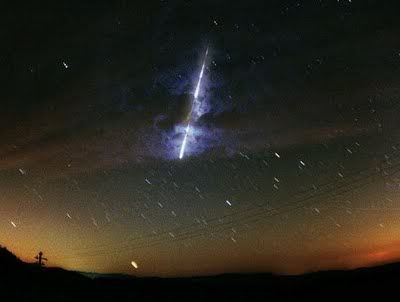
Hujan meteor yang dapat kita saksikan di Indonesia ini terletak di Rasi Leo, pada hari puncaknya kita diuntungkan karena kondisi bulan pada saat itu sedang mengalami bulan baru , jadi sinar bulan yang redup tak akan menghalangi cahaya meteor yang terlihat.
Waktu yang tepat untuk melihatnya yaitu dini hari atau setelah tengah malam sampai subuh sebelum fajar terbit... Kecerahan meteor yang terlihat pengamat akan tergantung pula kondisi awan dan cuaca di daerah masing-masing. Mudah-mudahan gak hujan !
So buat kalian yang mau lihat peristiwa alam yang spektakuler ini, jangan lupa bawa pacar, teman, anak, bini, ato sapa kek buat begadang! Jangan sendirian nanti malah ditemenin mbak kunti loh! Hiii....
Sekedar Info
Yang penting di Indonesia jam berapa mulai, berakhirnya, sama puncaknya?
Kalau dari info artikel kan jamnya yang ditulis jam ketika hujan meteor ini mencapai puncaknya di Amerika.
Nah yang di Indonesia jam berapa?
Kalau di itung, kan kita UTC +7 (barat), UTC +8 (tengah), UTC +9 (timur)
brarti :
- first wave hujan meteor itu mulai tanggal 17 jam
16:00 (barat), 17:00 (tengah), 18:00 (timur),
- second wave hujan meteor tanggal 18 jam
4:00 (barat), 5:00 (tengah), 6:00 (timur)
Semoga Berkenan
Spesial thx buat forum sebelah
*maaf ts sengaja mengcopas ini buat sekedar berbagi informasi buat yang belum tau
Jangan Lewatkan Salah Satu Hujan Meteor Terbesar Tahun Ini!

Nih berita dari website NASA

The 2009 Leonid Meteor Shower
November 10, 2009: This year's Leonid meteor shower peaks on Tuesday, Nov. 17th. If forecasters are correct, the shower should produce a mild but pretty sprinkling of meteors over North America followed by a more intense outburst over Asia. The phase of the Moon will be new, setting the stage for what could be one of the best Leonid showers in years.
see caption"We're predicting 20 to 30 meteors per hour over the Americas, and as many as 200 to 300 per hour over Asia," says Bill Cooke of NASA's Meteoroid Environment Office. "Our forecast is in good accord with independent theoretical work by other astronomers".
Leonids are bits of debris from Comet Tempel-Tuttle. Every 33 years the comet visits the inner solar system and leaves a stream of dusty debris in its wake. Many of these streams have drifted across the November portion of Earth's orbit. Whenever we hit one, meteors come flying out of the constellation Leo.
"We can predict when Earth will cross a debris stream with pretty good accuracy," says Cooke. "The intensity of the display is less certain, though, because we don't know how much debris is in each stream." Caveat observer!
The first stream crossing on Nov. 17th comes around 0900 UT (4 a.m. EST, 1 a.m. PST). The debris is a diffuse mix of particles from several old streams that should produce a gentle display of two to three dozen meteors per hour over North America. Dark skies are recommended for full effect.
"A remarkable feature of this year's shower is that Leonids will appear to be shooting almost directly out of the planet Mars," notes Cooke.
It's just a coincidence. This year, Mars happens to be passing by the Leonid radiant at the time of the shower. The Red Planet is almost twice as bright as a first magnitude star, so it makes an eye-catching companion for the Leonids: sky map.
The next stream crossing straddles the hour 2100-2200 UT, shortly before dawn in Indonesia and China. At that time, Earth will pass through a pair of streams laid down by Comet Tempel-Tuttle in 1466 and 1533 AD. The double crossing could yield as many as 300 Leonids per hour.

Above: This side of Earth will be facing the Leonid debris stream at the time of the Nov. 17th outburst. Observers in India, China and Indonesia are favored with dark, pre-dawn skies. Image credit: Danielle Moser of the NASA Meteoroid Environment Office.
"Even if rates are only half that number, it would still be one of the best showers of the year," says Cooke.
The Leonids are famous for storming, most recently in 1999-2002 when deep crossings of Tempel-Tuttle's debris streams produced outbursts of more than 1000 meteors per hour. The Leonids of 2009 won't be like that, but it only takes one bright Leonid streaking past Mars to make the night worthwhile.
Enjoy the show.
Author: Dr. Tony Phillips | Credit: Science@NASA
Source: http://science.nasa.gov/headlines/y2009/10nov_leonids2009.htm
Sorry gak ada translatenya, tadi ane translate di google malah jadi acak-acakan...
Nih sumber lainnya:
Earthsky.org
Yes, the famous Leonid meteor shower will peak tonight – actually, before dawn tomorrow according to U.S. clocks. Best of all, the new moon today will guarantee a moon-free night tonight for meteor watching.
Our chart shows the radiant point in this annual shower – in the head of the constellation Leo. Meteors in annual showers stem from comets, and the radiant point is the point in the sky where we cross the comet’s orbit. It’s kind of like the point in the distance where train tracks converge.
The radiant for the Leonids is near the star Algieba. This is not Leo’s brightest star – that distinction goes to the star Regulus. Both Algieba and Regulus belong to a noticeable pattern on the sky’s dome, in the shape of a backwards question mark. This pattern is called “the Sickle.” In years when the moon is out of the way, the paths of Leonid meteors can be traced backwards to this Sickle pattern.
Leo rises in the wee hours after midnight in November, which explains why this meteor shower – like most annual meteor showers – is typically best after midnight. Can you see that you’ll observe more meteors when the radiant point is well above the horizon? Otherwise, some meteors are blocked by the body of Earth itself.
In good years for the Leonids, you don’t need to know how to recognize Leo to see the meteors. But we thought you’d enjoy knowing where the radiant is tonight, so you can imagine the meteors pouring from this point in the sky, in a sky totally free of moonlit glare!
http://www.earthsky.org/tonighthome/2009-11-16/url
November 17th and 18th - Leonids Meteor Shower Predictions
The Leonids meteor shower is one of the better meteor showers to observe. It produces an average of 40 meteors per hour during their peak. The shower itself has a cyclic peak year every 33 years where hundreds of meteors can be seen each hour. The last event like that occurred in 2001.
The shower peaks this year on November 17th and 18th, but you can normally see some meteors from November 13th through the 20th. The moon is set to be totally out of the way this year, granting an exceptional viewing experience for the Leonids.
Look for the shower radiating (where they appear to start) from the constellation Leo after just after midnight.
Looks to be setup for great viewing opportunities
http://www.armageddononline.org/Leonids-Meteor-Shower-november-2009.html
Yes, the famous Leonid meteor shower will peak tonight – actually, before dawn tomorrow according to U.S. clocks. Best of all, the new moon today will guarantee a moon-free night tonight for meteor watching.
Our chart shows the radiant point in this annual shower – in the head of the constellation Leo. Meteors in annual showers stem from comets, and the radiant point is the point in the sky where we cross the comet’s orbit. It’s kind of like the point in the distance where train tracks converge.
The radiant for the Leonids is near the star Algieba. This is not Leo’s brightest star – that distinction goes to the star Regulus. Both Algieba and Regulus belong to a noticeable pattern on the sky’s dome, in the shape of a backwards question mark. This pattern is called “the Sickle.” In years when the moon is out of the way, the paths of Leonid meteors can be traced backwards to this Sickle pattern.
Leo rises in the wee hours after midnight in November, which explains why this meteor shower – like most annual meteor showers – is typically best after midnight. Can you see that you’ll observe more meteors when the radiant point is well above the horizon? Otherwise, some meteors are blocked by the body of Earth itself.
In good years for the Leonids, you don’t need to know how to recognize Leo to see the meteors. But we thought you’d enjoy knowing where the radiant is tonight, so you can imagine the meteors pouring from this point in the sky, in a sky totally free of moonlit glare!
http://www.earthsky.org/tonighthome/2009-11-16/url
November 17th and 18th - Leonids Meteor Shower Predictions
The Leonids meteor shower is one of the better meteor showers to observe. It produces an average of 40 meteors per hour during their peak. The shower itself has a cyclic peak year every 33 years where hundreds of meteors can be seen each hour. The last event like that occurred in 2001.
The shower peaks this year on November 17th and 18th, but you can normally see some meteors from November 13th through the 20th. The moon is set to be totally out of the way this year, granting an exceptional viewing experience for the Leonids.
Look for the shower radiating (where they appear to start) from the constellation Leo after just after midnight.
Looks to be setup for great viewing opportunities
http://www.armageddononline.org/Leonids-Meteor-Shower-november-2009.html


Liat jadwal Hujan Meteor 2009
Menurut sumber tertulis, aktifitas hujan meteor ini akan berlangsung pada tanggal 10 s/d 23 November 2009, namun puncaknya akan berlangsung pada 17 November 2009.

Hujan meteor yang dapat kita saksikan di Indonesia ini terletak di Rasi Leo, pada hari puncaknya kita diuntungkan karena kondisi bulan pada saat itu sedang mengalami bulan baru , jadi sinar bulan yang redup tak akan menghalangi cahaya meteor yang terlihat.
Waktu yang tepat untuk melihatnya yaitu dini hari atau setelah tengah malam sampai subuh sebelum fajar terbit... Kecerahan meteor yang terlihat pengamat akan tergantung pula kondisi awan dan cuaca di daerah masing-masing. Mudah-mudahan gak hujan !
So buat kalian yang mau lihat peristiwa alam yang spektakuler ini, jangan lupa bawa pacar, teman, anak, bini, ato sapa kek buat begadang! Jangan sendirian nanti malah ditemenin mbak kunti loh! Hiii....
Sekedar Info
Yang penting di Indonesia jam berapa mulai, berakhirnya, sama puncaknya?
Kalau dari info artikel kan jamnya yang ditulis jam ketika hujan meteor ini mencapai puncaknya di Amerika.
Nah yang di Indonesia jam berapa?
Kalau di itung, kan kita UTC +7 (barat), UTC +8 (tengah), UTC +9 (timur)
brarti :
- first wave hujan meteor itu mulai tanggal 17 jam
16:00 (barat), 17:00 (tengah), 18:00 (timur),
- second wave hujan meteor tanggal 18 jam
4:00 (barat), 5:00 (tengah), 6:00 (timur)
Semoga Berkenan
Spesial thx buat forum sebelah
*maaf ts sengaja mengcopas ini buat sekedar berbagi informasi buat yang belum tau


